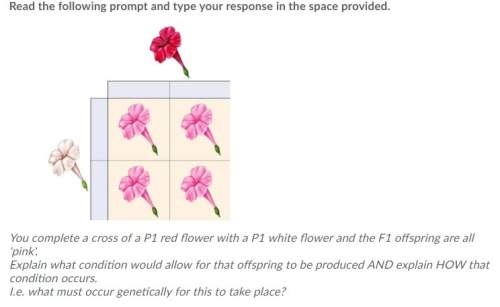
Biology, 25.12.2019 15:31 loredobrooke5245
In a cladogram, when does a group of organisms branch off? when a new trait evolves when an ancestor becomes extinct when it is discovered when it becomes large enough

Answers: 3


Another question on Biology

Biology, 22.06.2019 04:00
Will mark brainliest i only need the ! 1.use ten beads and a centromere of one color to construct the long chromosome. use ten beads and a centromere of a second color to construct the second chromosome in the long pair. make a drawing of the chromosomes in the space below. 2. for the second pair of chromosomes, use only five beads. 3. now model the replication of the chromosomes. make a drawing of your model in the space below. part b: meiosis i during meiosis i, the cell divides into two diploid daughter cells. 4. pair up the chromosomes to form tetrads. use the longer tetrad to model crossing-over. make a drawing of the tetrads in the space below. 5. line up the tetrads across the center of your “cell.” then model what happens to the chromosomes during anaphase i. 6. divide the cell into two daughter cells. use the space below to make a drawing of the result. part c: meiosis ii during meiosis ii, the daughter cells divide again. 7. line up the chromosomes at the center of the first cell, one above the other. separate the chromatids in each chromosome and move them to opposite sides of the cell. 8. repeat step 7 for the second cell. 9. divide each cell into two daughter cells. use the space below to make a drawing of the four haploid cells
Answers: 1

Biology, 22.06.2019 13:00
14) whenever diploid populations are in hardy-weinberg equilibrium at a particular locus a) the allele's frequency should not change from one generation to the next, but its representation in homozygous and heterozygous genotypes may change. b) natural selection, gene flow, and genetic drift are acting equally to change an allele's frequency. c) this means that, at this locus, two alleles are present in equal proportions. d) the population itself is not evolving, but individuals within the population may be evolving.
Answers: 2

Biology, 22.06.2019 20:10
Which of the following accurately describes the correct order of events in the process of transpiration within a plant? a. water enters the roots, passes through the leaves, and leaks through the stem pores. b. water enters the roots, gets transported through the stem, and evaporates through the leaves. c. water is absorbed through the leaves, is transported through the stem, and nourishes the roots. d. water is absorbed through the leaves, nourishes the roots, and leaks through the stem pores.
Answers: 1

Biology, 22.06.2019 20:30
Which best describes somatic mutations? they are usually passed on to offspring. they can cause different kinds of cancer. they always result from point mutations. they only occur in reproductive cell
Answers: 2
You know the right answer?
In a cladogram, when does a group of organisms branch off? when a new trait evolves when an ancesto...
Questions




Mathematics, 22.08.2019 10:20

Geography, 22.08.2019 10:20





Mathematics, 22.08.2019 10:20

Mathematics, 22.08.2019 10:20



Biology, 22.08.2019 10:20


History, 22.08.2019 10:20


History, 22.08.2019 10:20

Mathematics, 22.08.2019 10:20




